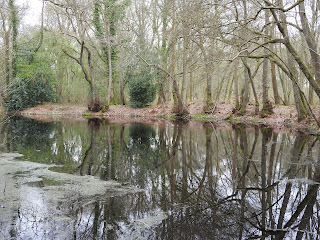It was time to move on from Shamley Green. As I went onward along the tracks, between the yellow green grass I would see glimpses of the canal.
I passed where the canal opened up into pool in the middle of a wood, providing a turning place.
Eventually I reached the place where the canal remnants pass through Sidney Wood, on the Surrey and Sussex border, where canal's watershed exists.
Old map showing in the centre Sidney Wood, with the Wey and Arun Canal winding through the wood to reach Loxwood.
The woods yield a rich history, including the lives of the charcoal burners and the glassblowers who used their charcoal. The glassblowing is reputed to have started in Roman times and continued until the 1600s. Sand was brought from Hambledon, and ash for flux was obtained from bracken and lime was imported. Until comparatively recently, fragments of fireproof crucibless used as furnaces could be found in the woods.
Smuggling occurred in the 18th and early 19th century in which the ruins of the glasshouses were used to store smuggled goods.
The tradition of glass work lingers on, and, on another occasion, I was able to buy a beautiful vase made nearby at the Smithbrook Kilns.
The track took me into the woodland and inevitably I got lost. I continued to follow the track, the direction of the sun telling me that I was at least going roughly south.
I kept going in hope that something would turn up, but time was moving on and I was becoming more disorientated. Eventually I had to admit I was lost.
Just as this thought occurred I looked to the left and saw through the undergrowth the canal - I had found again London's Lost Route to the Sea.
It stretched out in a south easterly direction, guiding me. The mossy banks of the canal led me onward between trees towards my destination.








No comments:
Post a Comment